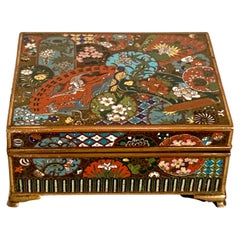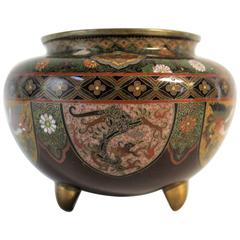East Asian Metalwork
1
to
1
1
1
1
1
1
1
1
1
1
1
1
2
20
16
6
5
Place of Origin: East Asian
Creator: Miyamoto Shoko
Japanese Meiji Period Sterling Silver 2 Handled Basket by Katsu Miyamoto
By Miyamoto Shoko 1
Located in Dallas, TX
PRESENTING a GORGEOUS, VERY HIGH QUALITY and EXTREMELY RARE piece of Japanese Meiji Period Sterling Silver 2 Handled Basket by Katsu Miyamoto.
EXQUISITE, EXCEPTIONAL, RARE & IMPORTANT!
This is definitely a Meiji Period piece due to the fact that it is marked with the sterling silver mark “jungin”.
The Meiji period was from 1868 to 1912 and in 1928 a law was introduced in Japan compelling the use of decimal marks for silver.
This pre-dates that decimalization law.
We are of the opinion that it is from circa 1900.
Miyamoto Shoko was founded in 1880 as the first silverware specialty shop. In 1899, Miyamoto Shoko’s silverwares were ordered by the family members of the Emperor of Japan, and to this day, they are making fine and graceful handicrafts with skillful craftsmen.
Loved by numerous customers since the Meiji era, Miyamoto Shoko’s products have also been given to Princess Mako and Princess Kako of Akishino, as well as Princess Aiko Toshinomiya, on their birthdays.
Katsu Miyamoto (宮本勝), in 1880, in order to increase the sales of tobacco and cigarettes to foreigners founded the Moyamoto Shoko company, which produced different silverwares in general and particularly silver cigarette cases. Miyamoto’s first name, Katsu (勝) in some sources is written as “Masaru”, since 勝 kanji can be pronounced in both ways.
This basket is of the HIGHEST QUALITY imaginable!
The top of the basket has the MOST GORGEOUS repousse work of flowers, probably lotus flowers, with leaves and foliage. It has an underlying chevron effect chasing, reflecting parquetry.
The 2 handles are cast in the form of bamboo handles.
The rim of the top likewise is cast as bamboo.
The base is equally stunning in a different way!
It is chased with a chevron effect, like parquetry flooring and the four feet simulate pieces of sliced bamboo with an interlinking gallery of support columns, likewise, simulating bamboo.
The QUALITY of WORKMANSHIP is OUTSTANDING!
The pieces weighs exactly 525 grams.
This piece takes my breath away!
This is one for the SERIOUS COLLECTOR of EXQUISITE AND RARE Japanese silver. You will not find another like it, for sale ANYWHERE ELSE IN THE WORLD …… I know as I have searched!
Provenance: Acquired from a Dallas Private Collector.
Dimensions: 9.6 inches wide, 7.6 inches deep and 2.75 inches tall ( 7.25 inches tall with handles up)
Condition: Very good. It looks like the base 4 legged gallery, has been repaired/re-attached to the base, but otherwise it is excellent and of Museum quality.
The Meiji period (明治時代 Meiji-jidai?), also known as the Meiji era, is a Japanese era which extended from October 23, 1868 through July 30, 1912.[1] This period represents the first half of the Empire of Japan during which Japanese society moved from being an isolated feudal society to its modern form. Fundamental changes affected its social structure, internal politics, economy, military, and foreign relations. The period corresponded with the reign of Emperor Meiji after 1868, and lasted until his death in 1912. It was succeeded by the Taishō period upon the accession of Emperor Taishō to the throne.
Solid silver pieces...
Category
Early 20th Century Meiji East Asian Metalwork
Materials
Sterling Silver
Related Items
Japanese Cloisonne Box, Meiji Period, Late 19th Century, Japan
Located in Austin, TX
A very fine and intricately decorated Japanese cloisonné box and cover, Meiji period, late 19th century, Japan.
The lidded trinket or jewelry...
Category
1890s Meiji Antique East Asian Metalwork
Materials
Brass, Copper, Enamel
Japanese Meiji Period Cloisonne Bowl
Located in Hamilton, Ontario
Japanese Meiji period cloisonne bowl.
Category
19th Century Meiji Antique East Asian Metalwork
Japanese Silver Incense Burner, Akoda Koro, by Norurma, Meiji Period, Japan
Located in Austin, TX
A lovely and luxurious Japanese silver incense burner of lobed melon form, akoda koro, marked jungin and signed Nomura, Meiji Period, circa 1900, Japan.
The silver koro...
Category
1910s Meiji Vintage East Asian Metalwork
Materials
Silver, Sterling Silver
Japanese Meiji Period Komai Damascene Box Fujii Yoshitoyo
Located in Newark, England
Fine Japanese Damascene Meiji period box in the komai style. The box of flower head shape with inlaid gold, the hinged cover with a scene comprising...
Category
Late 19th Century Meiji Antique East Asian Metalwork
Materials
Metal
Japanese Cloisonne Box by Inaba, Meiji Period, circa 1900, Japan
By Inaba Cloisonne Co.
Located in Austin, TX
A fine Japanese cloisonne hinged box with pheasant and autumn foliage, by Inaba Nanaho and the Inaba Cloisonne Company, Meiji period, circa 1900, Japan.
The lovely jewelry or trin...
Category
Early 1900s Meiji Antique East Asian Metalwork
Materials
Copper, Enamel, Metal
Japanese Meiji Period Cloisonne Enamel Sake Pot
Located in Newark, England
Fine Japanese Meiji period cloisonne enamel Sake pot. The Sake pot of rounded form with with clean edges profusely decorated with blossoming flowers throughout upon a black ground ba...
Category
Late 19th Century Meiji Antique East Asian Metalwork
Materials
Metal, Enamel
Large Japanese Meiji Period Open Bronze Censor
Located in Hudson, NY
This cast bronze censor is from Japan and was made circa 1880. Raised up on three legs which issue from demons mouths the container is cast with reliefs ...
Category
Late 19th Century Meiji Antique East Asian Metalwork
Materials
Bronze
Japanese Meiji Twin Handled Bronze Vase with Silver, Brass & Copper Inlay
Located in Bishop's Stortford, Hertfordshire
A fine antique Japanese Meiji twin handled bronze vase decorated with floral designs in silver, brass and copper inlay dating from the 19th century...
Category
19th Century Meiji Antique East Asian Metalwork
Materials
Brass, Bronze, Copper, Silver
Free Shipping
H 6.89 in Dm 3.55 in
Japanese Meiji Period Hand Mirror
Located in Sharon, CT
Meiji period cast bronze hand mirror. Very fine casting quality depicting
typical Japanese motifs.
Category
Late 19th Century Meiji Antique East Asian Metalwork
Materials
Bronze
Japanese Sterling Silver Chrysanthemum Dish Meiji Period
By Musashiya
Located in Atlanta, GA
An exquisite Japanese sterling silver ornamental bonbon dish, circa 1890-1900. The piece was rendered in the shape of a stemmed branch of chrysanthemum blossom and was made for export market. Both botanically realistic and stylish, the piece showcases a high degree of artisanal sensitivity and technical ability of the silversmith who created this lovely piece. The petals that form the exteriors were outlined with deep and fluid relief lines of sculptural quality. The branches and leaves were rendered with attentions to the smallest details, with molding and surface texturizing using chasing in contrast with hammering. The interior of the dish is equipped with a conforming inner dish and when it is taken out, revealing the chased lines. The piece, although practical, is basically an okimono in sculptural form, a work of art on its own. It weighs about 22 ounces.
Under the dish, it is marked "Pure Silver" in Kanji and SM in a rectangular cartouche. The research (carried out by Adrien Von Ferscht, an expert and author on Asian Export Silver) identified it to be Sadajiro Musashiya...
Category
1890s Japonisme Antique East Asian Metalwork
Materials
Sterling Silver
Japanese Edo/Meiji Gilded Bronze Folded Paper Handled Basket with Applications
Located in Bishop's Stortford, Hertfordshire
An unusual antique Japanese gilded bronze basket of folded paper form body with applied panels and decoration dating from the 19th century and either late Edo or early Meiji period (...
Category
19th Century Edo Antique East Asian Metalwork
Materials
Bronze
Free Shipping
H 9.45 in Dm 7.68 in
Japanese Head Bucket (Kubi-Oke), Lacquer, Meiji Period
Located in Point Richmond, CA
Japanese Head Bucket (Kubi-Oke), Lacquer, Meiji period.
The head bucket was used for storing and transporting severed heads. During the Samurai era clashes and battles ensued, cutt...
Category
Early 20th Century Meiji East Asian Metalwork
Materials
Wood, Lacquer
Recently Viewed
View AllMore Ways To Browse
Antique Copper Tray Round
Arabic Pot
Asian Round Brass Tray
Meiji Plaque
Brass Incense Burner Antique
Copper Incense Burner
Iron Japan Teapot
Japanese Iron Teapot
Shang Dynasty Bronze
Stirrup Japan
Cloisonne Incense Burner
Antique Vajra
China Brazier
Chinese Brazier
Cast Iron Teapot
Chinese Antique Censer
Tibet Bell
Silver Koro


